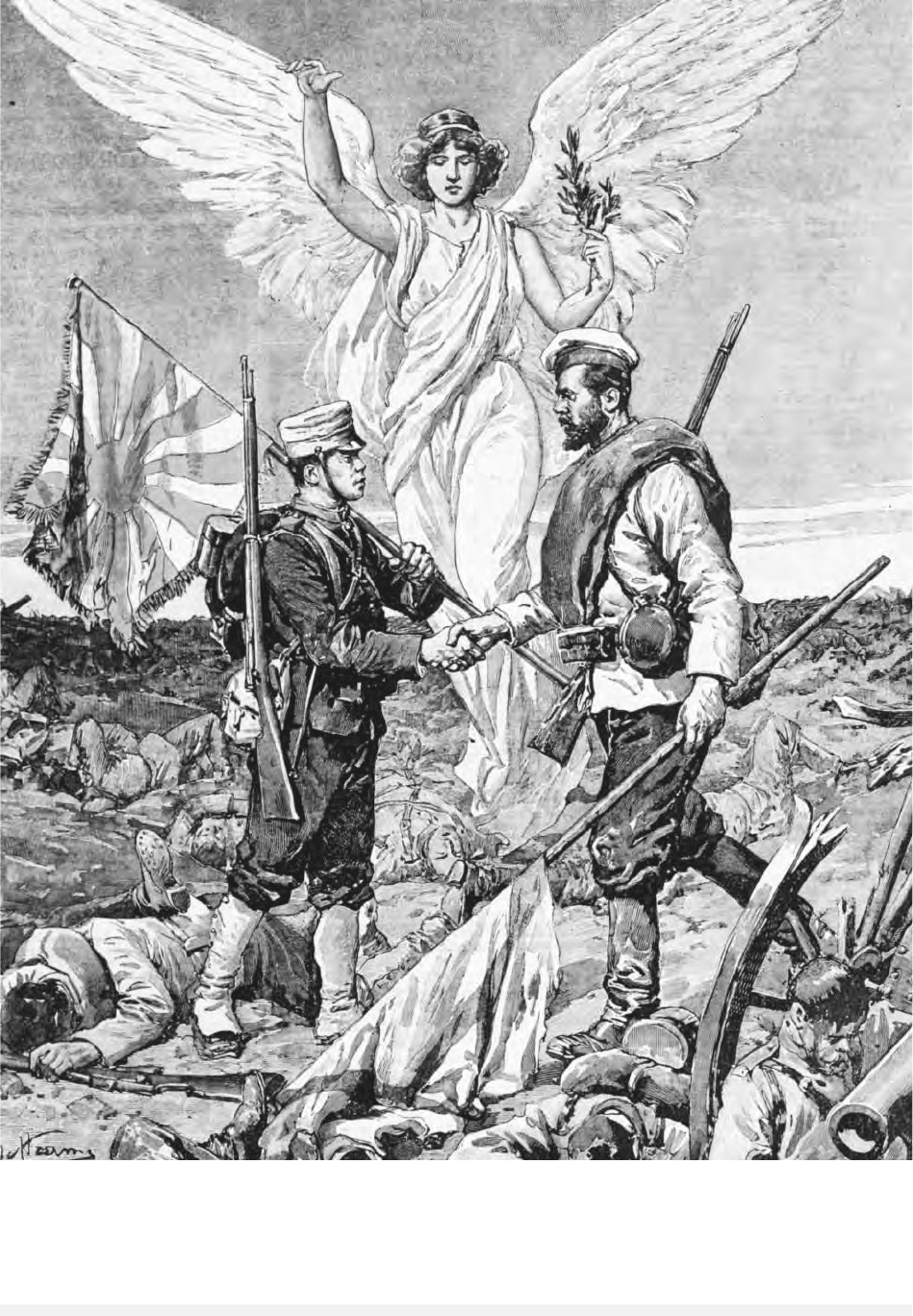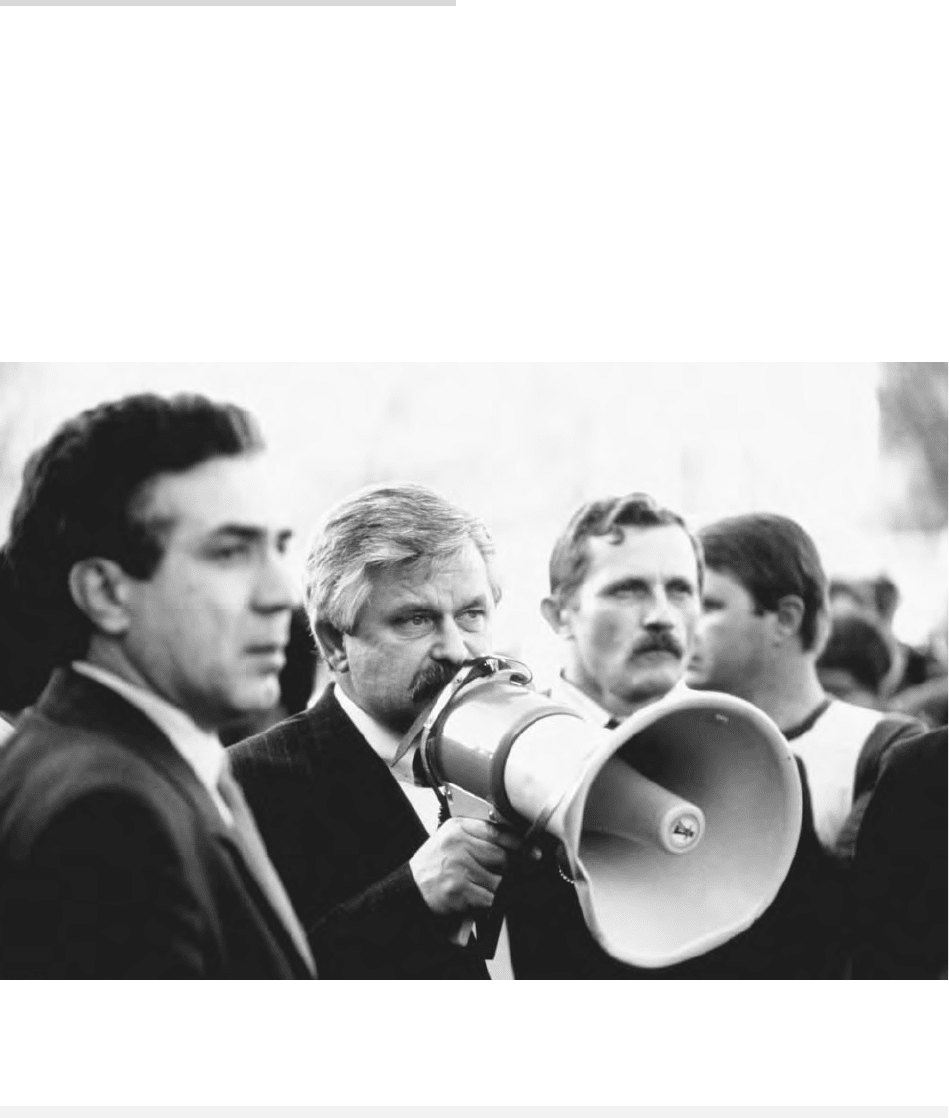Encyclopedia of Russian History
Подождите немного. Документ загружается.


Riasanovsky, Nicholas. (1967). Nicholas I and Official Na-
tionality in Russia, 1825–1855. Berkeley: University
of California Press.
Slezkine, Yuri. (1994). Arctic Mirrors: Russia and the Small
Peoples of the North. Ithaca, NY: Cornell University
Press.
Weeks, Theodore R. (1996). Nation and State in Late Im-
perial Russia: Nationalism and Russification on the
Western Frontier, 1863–1914. DeKalb, IL: Northern
Illinois University Press.
T
HEODORE
R. W
EEKS
RUSSO-JAPANESE WAR
After brokering the end of the Sino-Japanese War
(1894–1895) with the Treaty of Shimonoseki, Rus-
sia placed itself on a collision course with Japan
over the issue of spheres of influence in Manchuria.
Relations between the two countries further dete-
riorated in 1898, when Russia occupied the Chinese
fortress of Port Arthur (now Lu-shun), and again
in 1903, when Russian economic interest focused
on Korea. Japan’s response to Russia’s aggressive
eastern policy became apparent on February 8,
1904 when Admiral Heihachiro Togo launched a
surprise attack on Port Arthur. Having won con-
trol of the sea, the Japanese began landing land
troops at Chemulpo (now Inchon), as far north as
possible on the Korean Peninsula to avoid the bad
roads. Nonetheless, the weather did not cooperate,
and it was six weeks before General Tamemoto
Kuroki’s First Army was ready to march around
the northern tip of the Bay of Korea and invade the
Liao Tung Peninsula.
Russia, meanwhile, had entered the war un-
prepared for conflict in Asia. Its military planners
had given priority to the empire’s European fron-
tiers and had not dedicated sufficient resources to
the defense of its Asian interests. While the Japan-
ese considered mainland northeastern Asia vital to
their national security, the Russians viewed the re-
gion merely as a colonial interest for potential eco-
nomic development and wealth. No one understood
Russia’s predicament as clearly as War Minister
Alexei N. Kuropatkin, who, upon the outbreak of
war, resigned his ministerial portfolio, assumed
command of the Russian army, and proceeded to
Manchuria, where he arrived in March 1904. Since
his forces were being transferred from one end of
the empire to the other on the single-track and still
incomplete Trans-Siberian Railroad, Kuropatkin set
up defenses that he hoped would give Russia at least
three months to build up its military presence in
the Far East.
Kuropatkin began concentrating troops be-
tween Harbin and Liao Yang, but the Japanese
thwarted his plan by beginning operations in the
middle of March. The Japanese movements un-
nerved the commander of Port Arthur, General A.
M. Stoessel, who immediately appealed to Nicholas
II’s personally appointed viceroy for the Far East,
Admiral E. I. Alexiev, for help. Alexiev ordered
Kuropatkin to attack the Japanese, but the com-
mander-in-chief, holding that he was answerable
only to the tsar, refused. Thinking that Port Arthur
had supplies enough to withstand a long siege,
Kuropatkin had no intention of deviating from his
plan. Before this dispute could be resolved, the
Japanese forced Kuropatkin’s hand by defeating the
Russians in the hotly contested Battle of Nanshan
in April.
With Port Arthur’s supply lines cut after Nan-
shan, Kuropatkin no longer had the luxury of wait-
ing until an overwhelming force was assembled.
The major battles of the war followed: Va Fan Gou
(May), Liao Yang (August), and the river Sha Ho
(October), effectively concluding with Mukden in
February 1905. The Russians were soundly de-
feated in each of these battles by an enemy that
first out-thought and then outmaneuvered them.
Having concentrated three armies under the over-
all command of Marshal Iwao Oyama, the Japan-
ese were able to fight the war on their own terms.
Ironically, by the Battle of Mukden, Kuropatkin had
finally achieved numerical superiority just as the
Japanese reached the end of their material and hu-
man resources, but he, his staff, and the Russian
intelligence services never became aware of this ad-
vantage and were intimidated by the Japanese
army’s maneuverability. Further aggravating the
Russian predicament was the inexplicable capitula-
tion of Port Arthur on January 2, 1905. The situ-
ation was best described by the numerous military
observers representing most of the world’s nations,
who noted how unmotivated Russia’s army seemed
in comparison to the patriotic Japanese soldiers
with their strong sense of national mission.
A final event that captured the attention of the
world was the saga of Russia’s Baltic Fleet. By the
autumn of 1904, Russia’s Pacific Fleet lay in ruins,
and to regain control of the sea, Nicholas II ordered
the Baltic fleet to the Far East. Under the command
of Admiral Z. P. Rozhestvensky, the Baltic Fleet
sortied on October 15, 1904. Its round-the-world
RUSSO-JAPANESE WAR
1333
ENCYCLOPEDIA OF RUSSIAN HISTORY

RUSSO-JAPANESE WAR
1334
ENCYCLOPEDIA OF RUSSIAN HISTORY
Allegory on Russo-Japanese peace treaty, concluded in Portsmouth, NH. © T
HE
A
RT
A
RCHIVE
/D
OMENICA DEL
C
ORRIERE
/D
AGLI
O
RTI
(A)

voyage attracted the interest of the international
press, which reported its attack on British fishing
vessels on the Dogger Bank (the Russians mistak-
enly imagined that they were Japanese warships),
its search to find places to refuel and refit ships that
had not been designed for such an arduous jour-
ney; and its rendezvous with reinforcements at
Madagascar. By the time the fleet arrived in Asia,
Togo was lying in wait and had little difficulty de-
feating it in the Battle of the Tsushima Straits on
May 27, 1905, which dashed Russia’s last hopes.
The Russo-Japanese War was the first global
conflict of the modern era and the first war in
which an emerging Asian nation defeated a Euro-
pean great power. The Japanese victory inflamed
Asian nationalism and contributed to the struggle
against colonialism throughout the region. The
military debacle exposed the weakness of the tsarist
regime and is usually considered the prime cause
of the Revolution of 1905. After the complete de-
feat of Russia’s land and naval forces, the tsar sued
for peace. U.S. president Theodore Roosevelt bro-
kered the Treaty of Portsmouth (August 23, 1905),
but the Japanese believed that they had lost the
peace and did not trust Western diplomacy again
until after World War II. Finally, from the techni-
cal standpoint, the Russo-Japanese War was a pre-
cursor to World War I. Both sides mobilized mass
armies and used trenches, machine guns, and rapid-
fire artillery—weapons that help define the early
twentieth century battlefield.
See also: BALTIC FLEET; JAPAN, RELATIONS WITH; KOREA,
RELATIONS WITH; KUROPATKIN, ALEXEI NIKO-
LAYEVICH; MILITARY, IMPERIAL ERA; PORT ARTHUR,
SEIGE OF; PORTSMOUTH, TREATY OF; REVOLUTION OF
1905; TSUSHIMA, BATTLE OF
BIBLIOGRAPHY
Committee of Imperial Defence, Historical Section.
(1910–1920). Official History, Naval and Military, of
the Russo Japanese War. 3 vols. London: Committee
of Imperial Defence.
Connaughton, Richard M. (1988). The War of the Rising
Sun and Tumbling Bear: A Military History of the
Russo-Japanese War, 1904–05. London: Routledge.
Corbett, Julian S. (1994). Maritime Operations in the
Russo-Japanese War, 1904–05. 2 vols. Annapolis,
MD: Naval Institute Press.
German General Staff, Historical Section (1909). The
Russo-Japanese War, tr. Karl von Donat. 9 vols. Lon-
don: H. Rees.
Kinai, M., ed. (1907). The Russo-Japanese War: Official Re-
ports. 2 vols. Tokyo: Shimashido.
United States, War Department, General Staff. (1907).
Reports of Military Observers Attached to the Armies in
Manchuria during the Russo-Japanese War. 5 parts.
Washington, DC, Government Printing Office.
Walder, David. (1973). The Short Victorious War: The
Russo-Japanese Conflict, 1904–1905. New York:
Harper & Row.
Westwood, J. N. (1986). Russia against Japan, 1904–05:
A New Look at the Russo-Japanese War. Albany: State
University of New York Press.
J
OHN
W. S
TEINBERG
RUSSO-PERSIAN WARS
Disputes over territories along the southwestern
coast of the Caspian Sea and in the eastern Tran-
scaucasus led to war between Russia and Persia
from 1804 to 1813 and again from 1826 to 1828.
The military conflict between the two empires was
nothing new, but it entered a more decisive stage
with the dawning of the nineteenth century. At the
root of the first Russo-Persian War was the desire
of Shah Fath Ali to secure his northwestern terri-
tories in the name of the Qajar dynasty. At the
time, Persia’s claims to Karabakh, Shirvan, Talesh,
and Shakki seemed precarious in the wake of Rus-
sia’s annexation in 1801 of the former kingdom of
Georgia, also claimed by Persia. Meanwhile, Russia
consolidated this acquisition and resumed its mili-
tary penetration of border territories constituting
parts of modern Azerbaijan and Armenia, with the
objective of extending its imperial frontiers to the
Aras and Kura rivers.
War broke out when Prince Paul Tsitsianov
marched to Echmiadzin at the head of a column of
Russian, Georgian, and Armenian troops. The out-
numbered Russian army was unable to overcome
the town’s stubborn defense and several weeks later
also unsuccessfully besieged Yerevan. Throughout
the war, the Russians generally had the strategic
initiative but lacked the strength to crush the Per-
sian resistance. Able to commit only about ten
thousand troops, a fraction of their total force in
the Caucasus, the Russian commanders relied on
superior tactics and weapons to overcome a nu-
merical disadvantage of as much as five to one.
Overlapping wars with Napoleonic France, Turkey
(1806–1812), and Sweden (1808–1809), as well
as sporadic tribal uprisings in the Caucasus, dis-
tracted the tsar’s attention. Yet state-supported,
centralized military organization provided Russian
RUSSO-PERSIAN WARS
1335
ENCYCLOPEDIA OF RUSSIAN HISTORY

columns with considerable combat power. In con-
trast, the Persian forces were largely irregular
cavalry raised and organized on a tribal basis. Ab-
bas Mirza, heir to the throne, sought French and
British instructors to modernize his army, and re-
sorted to a guerrilla strategy that delayed the Per-
sian defeat.
In 1810, the Persians proclaimed a holy war,
but this had little effect on the eventual outcome.
The Russian victories at Aslandaz in 1812 and
Lankarin in 1813 sealed the verdict in Russia’s fa-
vor. Under the Treaty of Golestan, Russia obtained
most of the disputed territories, including Dages-
tan and northern Azerbaijan, and reduced the local
khans to the status of vassals.
Another war between Russia and Persia broke
out in 1826 following the death of Alexander I and
the subsequent Decembrist revolt. Sensing oppor-
tunity, the Persians invaded in July at the instiga-
tion of Abbas Mirza, and even won some early
victories against the outnumbered forces of Gen-
eral Alexei Yermolov, whose appeals to St. Peters-
burg for reinforcements went unfulfilled. With
only twelve regular battalions, the Russians effec-
tively delayed the Persian advance. A contingent
of about eighteen hundred, for instance, held the
strategic fortress at Shusha against a greatly su-
perior force. On September 12, a Persian army un-
der the personal command of Abbas Mirza was
defeated at Yelizabetpol. In the spring of 1827, the
Russian command passed to General Ivan Paske-
vich. He captured Yerevan at the end of September
and crossed the Aras River to seize Tabriz. In
November, Abbas Mirza reluctantly submitted.
Under the Treaty of Torkamanchay (February
1828), Persia ceded Yerevan and all the territory up
to the Aras River and paid a twenty million ruble
indemnity.
See also: CAUCASUS; GEORGIA AND GEORGIANS; IRAN, RE-
LATIONS WITH; MILITARY, IMPERIAL ERA
BIBLIOGRAPHY
Atkin, Muriel. (1980). Russia and Iran, 1780–1828. Min-
neapolis: University of Minnesota Press.
Curtiss, John S. (1965). The Russian Army under Nicholas
I, 1825–1855. Durham, NC: Duke University Press.
Kazemzadeh, Firuz. (1974). “Russian Penetration of the
Caucasus.” In Russian Imperialism: From Ivan the
Great to the Revolution, ed. Taras Hunczak. New
Brunswick, NJ: Rutgers University Press.
R
OBERT
F. B
AUMANN
RUSSO-TURKISH WARS
Between Peter the Great’s outright accession in
1689 and the end of Romanov dynastic rule in
1917, Russia fought eight wars (1695–1696, 1711,
1735–1739, 1768–1774, 1787–1792, 1806–1812,
1828–1829, and 1877–1878) either singly or with
allies against the Ottomans. In addition, Turkey
joined anti-Russian coalitions during the Crimean
War (1854–1856) and World War I (1914–1918).
Although these conflicts often bore religious over-
tones, the fighting was primarily about power and
possessions. Early on, Russian incursions into
Poland, the Baltics, the Crimea, and the southern
steppe threatened useful Ottoman allies. By the sec-
ond half of the eighteenth century, however, the
issue between St. Petersburg and Constantinople
had become one of titanic struggle for hegemony
over the northern Black Sea and its northern and
northwestern littoral. In the nineteenth century, the
issue came to involve Russian aspirations for in-
fluence in the Balkans and the Middle East, access
to the Mediterranean through the Turkish Straits,
and hegemony over the Black Sea’s Caucasian and
Transcaucasian littoral. As the rivalry became in-
creasingly one-sided in Russia’s favor, St. Petersburg
generally advocated maintenance of an enfeebled
Turkey that would resist outside interference and
influences while supporting Russia’s interests.
Russia scored its most important successes in
the Black Sea basin during Catherine II’s First
(1769–1774) and Second (1787–1792) Turkish
Wars. In particular, three of her commanders, Pe-
ter Alexandrovich Rumyantsev, Alexander Vasile-
vich Suvorov, and Grigory Alexandrovich Potemkin,
introduced into the fight a winning combination of
resolve, assets, tactical mastery, logistics, colonists,
and military-administrative support. Subsequently,
with Imperial Russian attention and assets diverted
elsewhere, and with the increasing interference of
the European powers on Turkey’s behalf, St. Pe-
tersburg proved unable to repeat Catherine’s suc-
cesses. Outside interference was no more evident
than in the aftermath of the Russo-Turkish War of
1877–1878, when considerable Russian gains in the
Balkans were virtually erased in June–July 1878
by the Congress of Berlin.
See also: MILITARY, IMPERIAL ERA; TURKEY, RELATIONS
WITH
BIBLIOGRAPHY
Aksan, Virginia H. (2002). “Ottoman Military Matters.”
Journal of Early Modern History 6 (1):52–62.
RUSSO-TURKISH WARS
1336
ENCYCLOPEDIA OF RUSSIAN HISTORY

Kagan, Frederick W., and Higham, Robin, eds. (2002).
The Military History of Tsarist Russia. New York: Pal-
grave.
Menning, Bruce W. (1984). “Russian Military Innova-
tion in the Second Half of the Eighteenth Century.”
War & Society 2 (1):23–41.
B
RUCE
W. M
ENNING
RUTSKOI, ALEXANDER VLADIMIROVICH
(b. 1947), vice president of the Russian Federation,
governor of Kursk Oblast, general-major of avia-
tion, Hero of the Soviet Union.
Alexander Rutskoi was born on September 16,
1947 in Kmelnitsky, Ukraine, to a professional mil-
itary family. He graduated from a pilot training
school in 1966 and joined the Soviet Air Forces. In
the 1980s he served in Afghanistan as deputy
commander, commander of the air regiment, and
deputy commander of aviation for the Fortieth
Army. He was shot down twice; the second time,
his Su-25 crashed in Pakistan, where he was in-
terned and then repatriated. In late 1988 he received
the award Hero of the Soviet Union. In 1988 and
1989 he attended the Voroshilov Military Academy
of the General Staff. In 1990 he was elected to the
Supreme Soviet of the RSFSR (Russian Federation)
and to the Central Committee of the newly orga-
nized Communist Party of the RSFSR. He displayed
a strong Russian nationalist bias and in 1991 helped
to found Communists for Democracy and sup-
ported Boris Yeltsin.
Yeltsin named Rutskoi as his vice presidential
running mate in his successful campaign for the
presidency of Russia. During the August Coup
(against Gorbachev), Rutskoi organized the defense
of the Russian White House. Yeltsin promoted him
to the rank of general-major and entrusted him
with a number of delicate issues, such as border is-
sue negotiations with Ukraine and Kazakhstan and
Chechen independence. When Yeltsin embarked
upon radical economic reforms, Rutskoi publicly
expressed his doubts concerning the direction of
RUTSKOI, ALEXANDER VLADIMIROVICH
1337
ENCYCLOPEDIA OF RUSSIAN HISTORY
Vice President Alexander Rutskoi tries to calm the crowd as his 1993 parliamentary rebellion begins to collapse. © M
ALCOLM
L
INTON
/L
IAISON
. G
ETTY
I
MAGES

Yeltsin’s policy. Yeltsin moved to effectively isolate
his vice president. As a consequence of these devel-
opments, Rutskoi drifted toward the parliamentary
opposition led by parliament speaker Ruslan Khas-
bulatov. This struggle between president and par-
liament came to a violent head in September and
October 1993. Yeltsin crushed the revolt with
armed forces and arrested its leadership. Rutskoi
was arrested and removed from the office of vice
president, and the position of vice president was
abolished.
In 1994 the Russian parliament granted amnesty
to Rutskoi and other rebels of 1993. Rutskoi went
on to organize a Russian nationalist party, Power
(Derzhava) which competed in the 1995 parlia-
mentary elections and joined the Red-Brown oppo-
sition to Yeltsin in the summer 1996 presidential
elections. A leading figure of the anti-Yeltsin na-
tionalist opposition, Rutskoi ran for and won the
post of governor of Kursk Oblast in October 1996
and served in that office to 2000. He stood for re-
election but was disqualified by the Central Elec-
tions Commission, which ordered his name stricken
from the ballot for election campaign law viola-
tions and abuses as governor. Rumors interpreted
the government’s actions as a direct response to
Rutskoi’s criticism of the president during the Kursk
disaster.
See also: AFGHANISTAN, RELATIONS WITH; AUGUST 1991
PUTSCH; KURSK SUBMARINE DISASTER; OCTOBER 1993
EVENTS; YELTSIN, BORIS NIKOLAYEVICH
BIBLIOGRAPHY
Aron, Leon. (2000). Yeltsin: A Revolutionary Life. New
York: Thomas Dunne Books.
Chugaev, Sergei. “Khasbulatov & Co.” Bulletin of the
Atomic Scientists (January/February 1993).
J
ACOB
W. K
IPP
RYBKIN, IVAN PETROVICH
(b. 1946), chair of the State Duma in 1994 and
1995, secretary of the Security Council from 1996
to 1998, and leader of the Socialist Party of Russia.
Ivan Rybkin was born on October 20, 1946, in
the Voronezh countryside. He graduated from the
Volgograd Agricultural Institute in 1968, com-
pleted graduate school there, and worked as a
teacher until 1983. With the beginning of pere-
stroika, he launched an ambitious political career
and became the second secretary of the Volgograd
Oblast committee of the Communist Party of the
Soviet Union. In 1990, he was selected as a peo-
ple’s delegate to the RSFSR, where he headed the
Communists of Russia fraction. In 1993 and 1994
he was vice-chair of the Executive Committee of
the Communist Party of the Russian Federation
(KPRF), but in April 1994 he left the KPRF. As of
the fall of 1993, he was a member of the Agrarian
Party, on whose list he was elected to the Duma.
In this capacity he proved a pragmatic politician.
He lost the support of the leftists (in 1995 he was
excluded from the Agrarian Party), but gained the
support of the Kremlin.
In the summer of 1995, the Kremlin brought
forth an initiative to create two centrist blocs for
the elections: a right-centrist bloc headed by Pre-
mier Viktor Stepanovich Chernomyrdin, and a left-
centrist bloc. This latter subsequently came to be
called the “Ivan Rybkin bloc,” which gained 1.1 per-
cent of the electoral votes. The bloc was dissolved,
but Rybkin was nonetheless elected to the Duma by
single-mandate district in his homeland, Voronezh
Oblast. Before the second round of presidential elec-
tions, Boris Yeltsin created the Political Advisory
Council to the President of the Russian Federation,
which included representatives of parties and pub-
lic associations that had not made it into the Duma.
Rybkin, who had recently registered the Socialist
Party, was appointed chair of the council. A few
months later, Rybkin replaced Alexander Lebed as
secretary of the Security Council, in which capac-
ity he worked until 1998, focusing mainly on
Chechnya. His deputy was for some time Boris Bere-
zovsky, with whom Rybkin maintains close rela-
tions.
In 2001–2002, with the discussion and adop-
tion of the law on political parties, which required
the presence of branch offices in at least half the
regions of the country, the processes of integration
strengthened considerably. From mid-2001 on-
ward, Rybkin participated in talks concerning the
creation of a United Social-Democratic Party of
Russia, along with Mikhail Gorbachev and other
well-known politicians. The unification process
was difficult, due not so much to divergence of
views as to a clash of ambitions. In the fall of 2001,
when the process seemed complete, Rybkin’s So-
cialist Party even disbanded, in anticipation of join-
ing forces with the new party, but the merger broke
at the last minute. It was effected only in March
2002, and on a visibly more modest scale.
RYBKIN, IVAN PETROVICH
1338
ENCYCLOPEDIA OF RUSSIAN HISTORY

On the basis of the Socialist Party, Alexei Pod-
berezkin’s Spiritual Heritage movement, and dozens
of small organizations with socialist tendencies, the
Socialist United Party of Russia was finally created.
Rybkin became its chair. The honeymoon period
was short, however, and within a few weeks, Ry-
bkin resigned as chair and the Socialist Party of
Russia left the coalition. In April 2003, at a con-
gress of the Socialist United Party of Russia, he was
officially removed from the position of chair and
excluded from the party. His alleged offenses in-
cluded an open letter to Putin, which called for end-
ing the Chechnya war and beginning negotiations
with Aslan Maskhadov; collaboration with the SPS;
and unsanctioned contacts with Berezovsky.
See also: CHECHNYA AND CHECHENS; PUTIN, VLADIMIR
VLADIMIROVICH
BIBLIOGRAPHY
McFaul, Michael. (2001). Russia’s Unfinished Revolution:
Political Change from Gorbachev to Putin. Ithaca: Cor-
nell University Press.
McFaul, Michael, and Markov, Sergei. (1993). The Trou-
bled Birth of Russian Democracy: Parties, Personalities,
and Programs. Stanford, CA: Hoover Institution Press.
McFaul, Michael; Petrov, Nikolai; and Ryabov, Andrei,
eds. (1999). Primer on Russia’s 1999 Duma Elections.
Washington, DC: Carnegie Endowment for Interna-
tional Peace.
Reddaway, Peter, and Glinski, Dmitri. (2001). The Tragedy
of Russia’s Reforms: Market Bolshevism against Democ-
racy. Washington, DC: U.S. Institute of Peace Press.
N
IKOLAI
P
ETROV
RYKOV, ALEXEI IVANOVICH
(1881–1938), Russian revolutionary and Soviet
politician, one of the leaders of the Right opposi-
tion.
Born in Saratov province, the son of a trades-
man, Alexei Rykov joined the Social Democratic
Party in 1898 and supported the Bolsheviks after
their split with the Mensheviks. He played an ac-
tive part in the 1905 revolution. In 1907, however,
he began to work for reconciliation between the
two wings of the party. In exile in Paris for two
years, he returned to Russia in 1911 but was soon
arrested and exiled to Siberia.
Returning to Moscow after the revolution of
February 1917, Rykov became a member of the
Moscow and Petrograd soviets and participated in
the October revolution. He became commissar for
internal affairs in the first Bolshevik government,
but resigned because of his support for a coalition
government. In April 1918, however, he accepted
the post of chairperson of the Supreme Council of
the National Economy, and in February 1921 he
became deputy chairman of Sovnarkom. After
Lenin’s death in January 1924 he became chair-
man. He was also a member of the Politburo from
1922 until 1930.
Rykov was a leading supporter of the New Eco-
nomic Policy, and allied with Stalin in his struggle
with Leon Davidovich Trotsky, Grigory Yevseye-
vich Zinoviev, and Lev Borisovich Kamenev, which
lasted from 1926 to 1928. When Stalin lashed out
against the Right Opposition, of which Rykov was
one of the leaders, he was defeated, discredited, and
ultimately dismissed from his senior positions by
1930. Rykov was arrested in February 1937. With
Nikolai Alexandrovich Bukharin and Genrikh Grig-
orevich Yagoda, Rykov was one of the leading de-
fendants at the third show trial, and was executed
in March 1938.
See also: BOLSHEVISM; FEBRUARY REVOLUTION; MENSHE-
VIKS; NEW ECONOMIC POLICY; OCTOBER REVOLUTION;
POLITBURO; RIGHT OPPOSITION; SOCIAL DEMOCRATIC
WORKERS PARTY; SOVNARKOM
D
EREK
W
ATSON
RYLEYEV, KONDRATY FYODOROVICH
(1795–1826), a poet who played a leading role in
organizing the mutiny of the military units in St.
Petersburg that occurred on December 14, 1825
(the so-called Decembrist Uprising).
Born into the family of an army officer, Kon-
draty Fyodorovich Ryleyev also became an officer
and served in units stationed in West Europe after
the defeat of Napoleon’s armies. He saw the gen-
eral backwardness of Russian society sharply con-
trasted with the capitalist countries of Western
Europe. Upon returning to St. Petersburg, Ryleyev
became active in a variety of social and political cir-
cles. In 1823 he joined the secret Northern Society.
Situated in St. Petersburg and headed by Nikita
Muraviev and Sergei Trubetskoi, it consisted of
moderate reformists who leaned toward establish-
ment of a constitutional monarchy, modeled after
RYLEYEV, KONDRATY FYODOROVICH
1339
ENCYCLOPEDIA OF RUSSIAN HISTORY

the English version. By contrast, the Southern So-
ciety, created by Pavel Pestel in Tulchin, gathered
together more radical members of the movement,
and demanded complete eradication of the extant
tsarist autocracy and the establishment of a de-
mocratic republic based upon on universal suffrage.
With the exception of his earliest works,
Ryleyev’s poems are romantic in style. Their
themes reflect patriotic sentiments and concern
with the course of Russian history. His verses ush-
ered in ideas about the duty to sacrifice one’s artis-
tic calling in service to the downtrodden masses
well before Nikolay Nekrasov preached them in his
own poetry. Tragically, Ryleyev was not able fully
to develop his poetic talents, and his celebrity is
mainly due to the martyrdom he underwent in the
cause of freedom. He was one of the five rebels who
were executed, along with Pestel, Kakhovskoi, Mu-
raviev-Apostol, and Bestuzhev-Riumin, for their
roles in the Decembrist Uprising. His sarcastic wit
has also become legend. Apparently, just as Ryleyev
was about to be hanged, the rope broke and he fell
to the ground. Bruised and battered, he got up, and
said, “In Russia they do not know how to do any-
thing properly, not even how to make a rope.” An
accident of this sort usually resulted in a pardon,
so a messenger was sent to Tsar Nicholas to know
his pleasure. The tsar asked, “What did he say?”
“Sire, he said that in Russia they do not even know
how to make a rope properly.” “Well, let the con-
trary be proved,” said Nicholas.
See also: DECEMBRIST MOVEMENT AND REBELLION
BIBLIOGRAPHY
Obolonskii, A. V., and Ostrom, Vincent. (2003). The Drama
of Russian Political History: System Against Individu-
ality. College Station: Texas A&M University Press.
J
OHANNA
G
RANVILLE
RYUTIN, MARTEMYAN
(1890–1937), leader of an anti–Stalin opposition
group that emerged within the Russian Commu-
nist Party in the 1930s.
Martemyan Ryutin was born on February 26,
1890, the son of a Siberian peasant from the
Irkutsk province. He joined the Bolshevik party in
1914. During the civil war, he fought against
Alexander Vasilievich Kolchak’s forces in Siberia,
and in the early 1920s he held party posts in
Irkutsk and Dagestan. In 1925, Ryutin became
party secretary in the Krasnaya Presnia district of
Moscow, and in 1927 he was elected a non-voting
member of the party Central Committee. In the
following year he incurred Stalin’s wrath for his
conciliatory attitude towards Bukharin and his fol-
lowers.
Experience of the collectivization drive con-
vinced Ryutin of the ruinous nature of Stalin’s eco-
nomic policies, and the criticisms he voiced led, at
the end of 1930, to his expulsion from the party
and a brief spell of imprisonment. In 1932, Ryutin
and some associates circulated a manifesto, “To All
Members of the Russian Communist Party,” which
condemned the Stalin regime and demanded Stalin’s
removal from power. Ryutin also composed a more
detailed analysis of Stalin’s dictatorship and eco-
nomic policies in the essay “Stalin and the Crisis of
the Proletarian Dictatorship” (first published in
1990). He was arrested, along with his group, in
September 1932. Although Stalin wanted the death
penalty, the Politburo, at the insistance of Sergei
Mironovich Kirov, rejected the demand, and Ryutin
was sentenced to ten years imprisonment. Ryutin,
however, was re-arrested in 1936 on a trumped-
up charge of terrorism, and was executed on Jan-
uary 10, 1937.
See also: KIROV, SERGEI MIRONOVICH; KOLCHAK, ALEXAN-
DER VASILIEVICH; PURGES, THE GREAT; STALIN, JOSEF
VISSARIONOVICH
BIBLIOGRAPHY
Conquest, Robert. (1990). The Great Terror: A Reassess-
ment. New York: Oxford University Press.
Getty, J. Arch, and Naumov, Oleg V. (1999). The Road
to Terror : Stalin and the Self–Destruction of the Bol-
sheviks, 1932-1939: Annals of Communism. New
Haven, CT: Yale University Press.
Medvedev, Roy Aleksandrovich, and Shriver, George.
(1989). Let History Judge: The Origins and Conse-
quences of Stalinism. New York: Columbia Univer-
sity Press.
Tucker, Robert C. (1990). Stalin in Power: The Revolution
from Above, 1928-1941. New York: Norton.
J
AMES
W
HITE
RYZHKOV, NIKOLAI IVANOVICH
(b. 1929), USSR prime minister under Gorbachev
and a leading figure in economic reform.
RYUTIN, MARTEMYAN
1340
ENCYCLOPEDIA OF RUSSIAN HISTORY

Born in Donetsk Oblast, Nikolai Ryzhkov joined
the Party in 1956 and graduated from the Ural
Polytechnical Institute in Sverdlovsk in 1959. He
spent his early career as an engineer at the Or-
dzhonikidze Heavy Machine-Building Institute and
was named director in 1970. Following his suc-
cesses in the Urals, Ryzhkov became involved in
all-union economic matters.
Ryzhkov served as a deputy in the USSR Coun-
cil of the Union (1974–1979) and a deputy in
the USSR Council of Nationalities (1974–1984).
Ryzhkov was first deputy chair of the USSR Min-
istry of Heavy and Transport Machine-Building
(1975–1979) and later first deputy chair of the
USSR State Planning Commission (Gosplan)
(1979–1982). He became a full member of the CPSU
Central Committee in 1981, chairing the Diplo-
matic Department (1982–1985) and later the USSR
Council of Ministers (September 1985–December
1990), making him the de facto Soviet prime min-
ister. Ryzhkov was the chief administrator of the
Soviet economy in the last half of the 1980s. He
became a full Politburo member in April 1985 and
chaired the Central Committee Commission that
assisted victims of the 1988 Armenian earthquake.
As the economy stalled, protests grew, and the
Kremlin debated the Five-Hundred-Day Plan, Ryzh-
kov suffered a heart attack on December 25, 1990.
He subsequently resigned, and Gorbachev replaced
him with Valentin Pavlov.
Ryzhkov unsuccessfully ran against Boris
Yeltsin for the Russian presidency in June 1991. He
then assumed a variety of corporate positions, in-
cluding chairman of the board of Tveruniversal
Bank (1994–1995), chairman of the board of
Prokhorovskoye Pole, and head of the Moscow In-
tellectual Business Club. He won a seat in the Russ-
ian State Duma in 1995 and 1999 as head of
“Power to the People,” a bloc aligned with the Com-
munist Party of the Russian Federation.
See also: CENTRAL COMMITTEE; GORBACHEV, MIKHAIL
SERGEYEVICH; GOSPLAN; PERESTROIKA; POLITBURO;
PRIME MINISTER
BIBLIOGRAPHY
Goldman, Marshall. (1992). What went Wrong with Per-
estroika. New York: Norton.
A
NN
E. R
OBERTSON
RYZHKOV, NIKOLAI IVANOVICH
1341
ENCYCLOPEDIA OF RUSSIAN HISTORY
This page intentionally left blank
